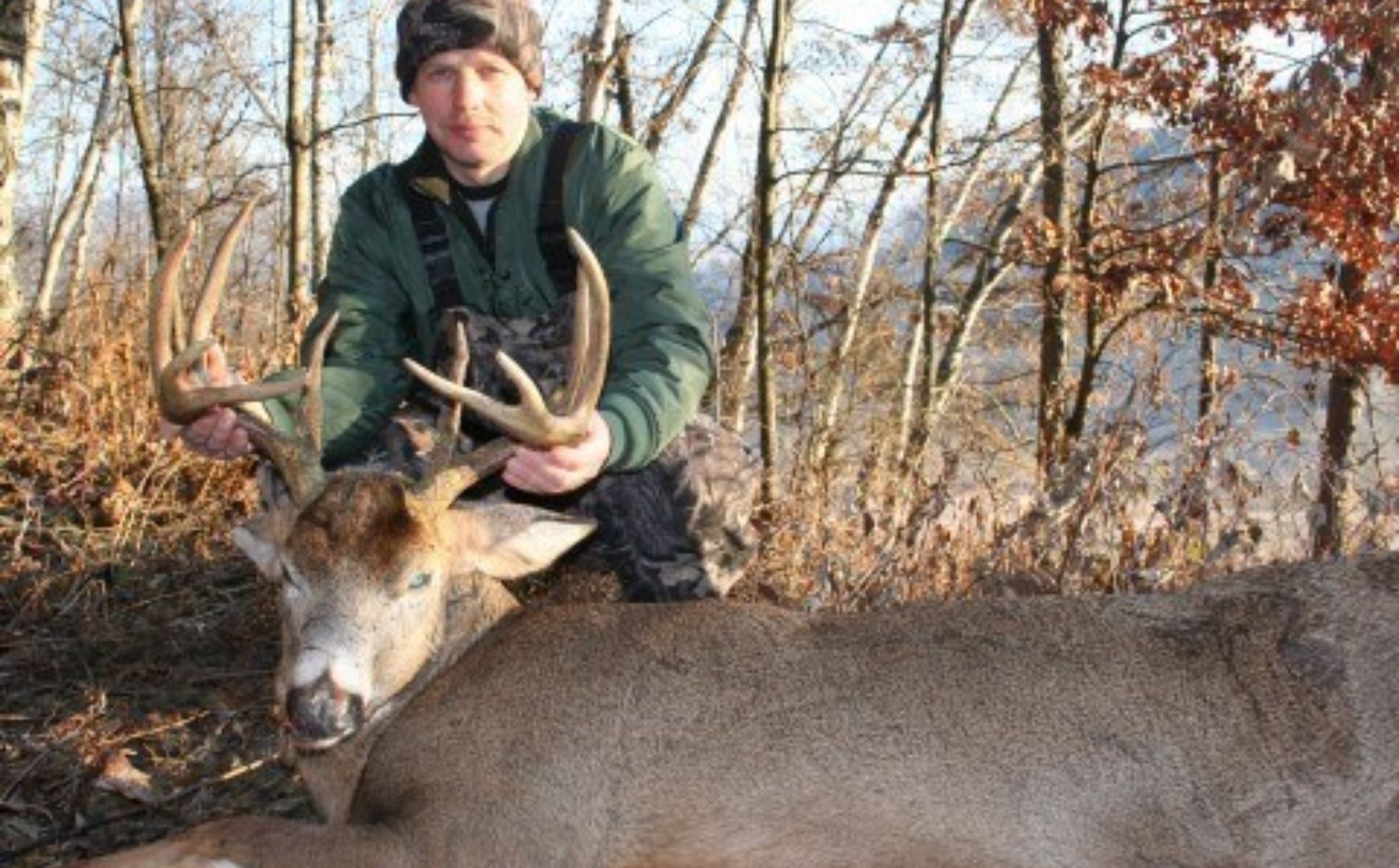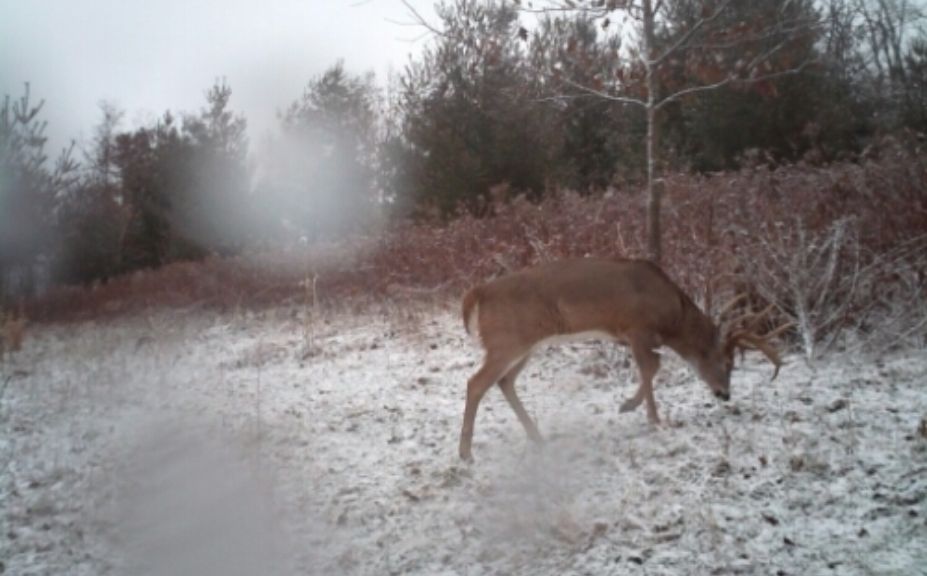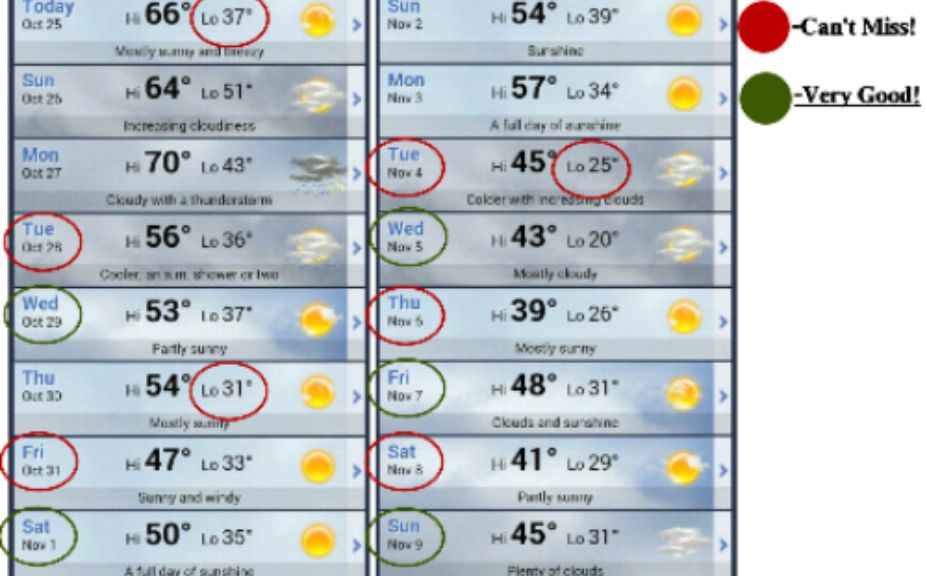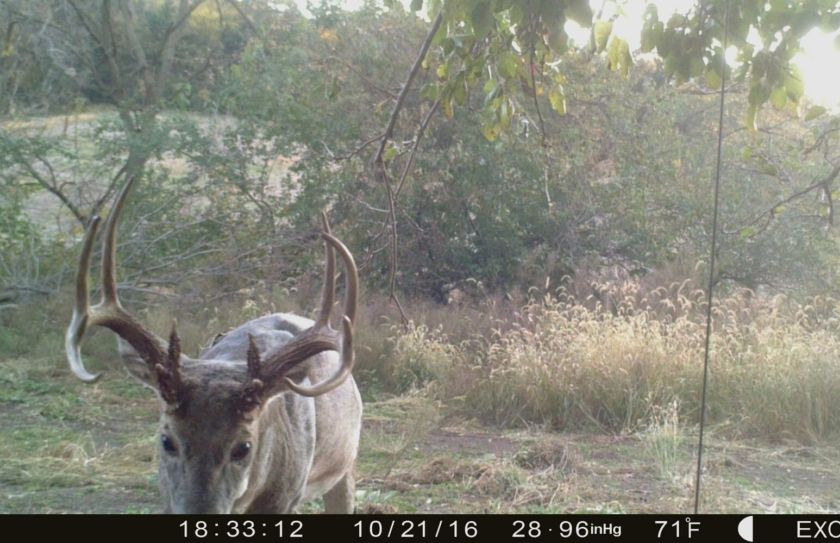
The only light in the woods was coming from the end of my small flashlight. When the light was off, it was black. When the light was on, the emptiness of the faint sliver of light cutting through the sub-freezing Northern Michigan swamp was comforting only because of the knowledge of a backup flashlight and bulb in my daypack. I had been in the swamps enough times to know that being a mile from the truck under dark skies with no discernible trail and only one flashlight was not a recipe for success. A spare bulb had saved me from spending a night in the woods in the past, and I was hoping that replacement bulbs and a spare flashlight would offer an even more certain outcome.
After an hour walk through thick brush on a faint trail that could only be followed with a compass and various landmarks, I could feel the beads of sweat slowly roll down my forehead. With the flashlight on to find the steps leading to the platform above, steam rose above and into the frozen black sky. Moisture was in the air, and the slight Southeast wind provided a foreshadowing of snow to come. As I climbed into my wilderness perch and settled in for the dark-to-dark all-day sit, I grabbed my pack for a much needed drink of water. There was no water in the first pocket, and then none in
the second. I started to worry a bit and realized that not only did I not have the water that I had planned to ration for the day, but I also didn't have the meal bar, the candy bar, cheese or apple. "Woops", I thought. Not that I couldn't stand to lose a few pounds, but with relatively few deer residing in the area, I realized that I could be in for a very long, foodless sit!
As the day broke to the warmth of the morning light, the chill of wet snow began to slowly erode any amount of warmth brought on by the new day. The snow came, went and then came againall day long. A small buck chasing a doe during the middle of the day made a couple of hours pass by more quickly, but did little to stop the unavoidable certainty of life's fragile grasp of fading protection from the elements. Without food or water, I was losing energy reserves at a rapid pace. By the end of the day I was shivering, stiff, and eager to speed up the typical one hour return to the truck. By the time I reached the ground to remove my gun from the hoist, my numb fingers could not unfasten the clasp. Even with heat packs and a Gore-Tex wrapped handwarmer muff, my fingers couldn't escape the enveloping cold.
Have you ever thought about what a whitetail deer goes through during a Fall cold front? Deer are rhythmic pattern feeders, feeding five times during a 24 hour period. Deer are also creatures of stress, meaning that patterns of stress (e.g., territorial stress, predator stress, rut stress, human stress, and of course, food-related weather stress) influence much of their lives. Just imagine being a mature buck hunkered down on a bench in a remote, lonely section of a wooded hollow. Only 24 hours ago the daytime high reached 72 degrees before stiff Southwesterly breezes turned to the North with gusts of over 30 mph. With trees cracking and branches dropping, not only are you not traveling to your preferred nighttime food source to dine under calm conditions, but you are anxious, wary, stressed, and losing energy reserves quickly as temperatures plummet with unforgiving icy winds. By the time the next day opens under cold, clear blue skies with a daytime high of 48, you - along with the rest of the deer herd - are ready to feed heavily.

*Post cold-front conditions are often cold, quiet, and full of mature buck movements that would not typically take place during warm or unstable conditions. These 2 monsters seemed content to appear during daylight hours after more than a full 3 months of hunting season had passed. 18 degrees, low winds and a fresh covering of snow were most likely contributing factors to their daytime travels.
Are you prepared to take advantage of the hunger pains of your local deer herd brought on by a hunting season cold front? What are your personal whitetail cold front hunting strategies? An early season lull in deer activity may be due to the fact that the rut hasn't started and the weather has been stable, boring and mild. However, a hunting season cold front can turn a lull into a quality opportunity and can significantly jumpstart your hunting during the rut. In fact, knowing when and how to hunt an Autumn cold front can be the number one factor in determining the timing of your hunting season success.
When Should You Hunt During a Cold Front?
Pre-Cold Front:
Weather conditions just prior to a passing cold front can sometimes offer an increase in quality opportunities. When light Easterly winds have yet to give way to harsh Northwesterly winds and the day has been cooled with solid cloud cover, deer often feel an increased urgency to feed. However, the timing of this period can be difficult to predict, as there may be only a narrow window of opportunity between warm, pre-front temperatures and ever-increasing wind speeds that accompany the advancing cold front. In 2008 I had an outstanding near opportunity on a 4-5 year old dark-racked Wisconsin monster that was harassing some fawns within 20 yards of me. He approached from out of the fog and filtered towards me, while moving with the Northeasterly winds, to my position along the edge of a CRP field. The temperatures had dropped several degrees from the day before, and a major cold front would bring a blanket of snow the following day. However, as soon as the mature does took one look at him and figured out exactly what he was after on that mid-November day, they high-tailed it to the woods with the fawns and mature buck in tow. In my experience, the opportunity for success prior to a cold front is typically accompanied by a drop in daytime temperatures. However, even though there may be a narrow window for success, it is often best to avoid disrupting a high-quality stand location that can be hunted in more optimal conditions, immediately after the cold front has passed.
Post-Cold Front Evening:
It was early October during Michigan's archery season, and I was looking forward to my first evening hunt of the young season. The skies were bright blue following a significant cold front that had passed during the previous two days, and the temperatures in the low 50's were forecasted to eventually fall into the upper 20's overnight. I settled into my stand within a clump of several mature spruce trees and awaited the parade of deer that would most certainly appear against the backdrop of conifers and brilliant Fall colors of maple, cherry, and poplar trees. I was not disappointed as a couple of doe family groups and several 1 to 2 year old bucks passed by within bow range, all headed toward a hidden interior food plot almost 200 yards away.

*Following the patterns of a cold front is my personal, #1 method for predicting when to sit in a tree. I rarely enter the woods without the influence of a cold-front shaping when, where and why I am using a particular treestand.
As shooting light faded and temperatures began to plummet into the low 40's, the crack of two sets of antlers being forced together startled a young buck in front of me. He stopped feeding and stared towards the large field in the distance as several does and fawns ran towards my stand location. As doe family groups often do when being agitated by a buck, they stopped and stared towards the direction from which they ran. When they began to move again and quickly filtered off to my right, I got ready. The buck responsible for the commotion soon came into view with a stiff-legged approach. He was a respectable 3 year old 9-pointer that had been previously captured on trail camera photos, but I wasn't interested in shooting him this evening. The cold front had provided for a great early-season sit, with trail cameras in that location suggesting that the activity observed this evening was higher than it had been that year.
The first quiet sit following a cold front may occur in the morning or evening, but I have found that post-cold front evenings can be an outstanding time to be in a stand that overlooks food source related movement patterns. For example, in 2011 I took advantage of an October 22nd quiet evening sit to harvest a 5 year old buck that grossed over 170 inches. He was following a food source corridor that had been sweetened by the addition of a water tank within bow range of the stand. His path of travel didn't take him completely to the water source, and he was still 150 yards from the edge of the food source when I connected on him, but he offered an outstanding opportunity at a time when many hunters were still a few weeks away from climbing into a stand to hunt a buck of that caliber. The one thing you can count on during an evening sit following a September or October cold front, is that you should be ready to enjoy the parade of deer against Fall's incredible splendor.
The late season is my favorite time of the hunting season to watch a food source movement following a significant cold front. Whether it be the late firearm, muzzleloader, or bow season, there is nothing better than watching deer file into a food source, particularly when food sources may be scarce in the surrounding neighborhood. Some of the nights that I have seen the most deer and have had some of my best encounters have been during a late-season evening food source hunt. Two out of my top five Michigan bucks were shot on the last day of firearm season and on the last day of muzzleloader season. In Wisconsin, I had an opportunity at an incredible 6 year old while he fed lazily, over an hour before dark, on the third to the last day of muzzleloader season. My best Pennsylvania public land buck was taken in December as the 4 year old 10-pointer and his buddy fed on acorns following a major cold front. Cold temperatures and a high-quality hidden food source can combine for incredible late-season hunting opportunities, but even those exciting times cannot compare to my favorite time to take advantage of a cold front - the morning after.
Post-Cold Front Morning
Approximately 80% of my mature bucks harvests - including all but two of my bucks that were 4 years or older - have been shot during morning hunts. Post-front mornings can offer some outstanding hunting season opportunities, but they typically are at their best only during a 4-week sweet spot in time, between pre-rut and traditional rutting activities. A case can be made for hunting early-season morning opportunities following a cold front, but great care should be taken to not spoil a better opportunity that may occur later during the evening, when just about every deer in the woods will be heading to food early. I like to take advantage of an early-season morning cold front by first identifying movements that are outside of the evening movements that I intend to hunt later in the day. The last thing I want to do is reduce the quality of an evening sit several hours before it even starts. I then focus on sections of habitat that feature natural food sources (e.g., apples or acorns) spread out over a long line of deer movement between food sources and bedding areas, where deer may be able to be ambushed as they continue to lazily feed into the morning hours. But when the time of the month begins turning from middle to end of October in the Midwest...be ready !
Various studies report that mature buck movement during the pre-rut to rut period is much greater in the morning than in the evening. After 3 decades of hunting, I would have to enthusiastically agree ! When you combine a cold front with the rut, there is no better time to hunt than in the morning. Hunting defined lines of deer movement between or on the downwind side of bedding areas, can not only be highly effective, but can often make for a very predictable hunt as well. One reason for the increased morning buck activity is the cold itself, since bucks are much more active when the temperatures are cold. A morning with a temperature in the 20's under calm, clear skies is a great start to the day. By noon it may still be less than 40 degrees even if the daytime high is likely to approach 60. By the time you enter a stand for an evening hunt, temperatures may still be close to 60 degrees and may drop down to only the low 50's by dark. Consequently, that leaves only a short window of opportunity of cooler temperatures in the evening compared to the cool morning temperatures that may last all the way until lunch time. My hunting partners and I typically kill our morning bucks during a window between 1 and 3 hours after daylight, as bucks seem to prefer that time to be cruising between and accessing bedding areas. We rarely shoot a mature buck right at first light, because it takes a while for them to travel several hundred yards back through the cover after spending a night in the major social hotspots created by preferred food sources. With the increased activity created by a cold front, you can often expect those rutting bucks in the morning to be closer to food sources than their bedding areas. This offers the hunter an outstanding opportunity to sneak into stand locations near bedding areas that you would likely have a hard time accessing during any other time of the year.
Late-Season Cold Fronts
Hunting season has passed its climax of significant hunting impact, acorns have long been gobbled up by an assortment of critters, agricultural fields have been picked, chopped and often plowed under, and frigid temperatures have slammed deer into an energy consumption rollercoaster that dictates the need for heavy feeding. While taking advantage of feeding times that do not expose them to the worst of winter weather including high winds, severe temperatures and blinding snow, deer will feed during periods of time that will allow them to both conserve and store energy at the same time. The calm before the storm during a pre-blizzard sit can be a great time to hunt, but be sure to hit the woods after the high winds die, the powdery snow settles, and cold clear skies take over. When high quality, late-season food sources are combined with low-pressured, high stem count mixed cover habitats, you just never know what mature buck may step out into your food plot during an evening sit. If you can keep the deer that are using your late season food plot from knowing that you are watching them as each evening passes, it only becomes a matter of time before the oldest buck using your food source steps out to feed during shooting hours.
Sitting over a significant late season food source can be one of the most magical hunts of the year. Soybeans, corn, and brassica plantings not only shine during cold northern temperatures, but they are often attractive even through a foot of snow or more. During a 12 degree 2007 mid-winter doe hunt in Southwest Wisconsin, we were able to drive the pickup across the frozen crust of over a foot of snow. Yet even with enough ice to support a full-sized truck, feeding sign indicated that deer were pounding through the icy layers to reach softball-sized turnips. Deer seem pretty adept at making the most out of their movements, so I won't speculate as to whether they were wasting more energy than they gained, but stomping through the ice and snow surely must have been a lot of work. With an appreciable amount of food, though, a late season cold front can certainly produce some can't-miss opportunities.
Bowhunting can be highly effective during the late season, but great care should be taken to preserve the deer movements to the evening food source. That may mean focusing only on stand locations that feature a safe downwind area to capture your scent, while watching access trails between cover and food. In addition, you may be better off avoiding a morning hunt in the late season, since deer may be bedded down during the coldest hours of the day, in an effort to preserve energy reserves. Furthermore, you may effectively destroy an evening hunt by spooking deer out of their bedding areas during your morning access. Late-season gun hunting can also be a lot of fun, when you take advantage of long-distance stands that allow you to enter and exit your stand location without spooking deer in a food source unless you fire a shot. It may be cold, but getting into a stand at least 3-4 hours before dark is a great practice as you attempt to beat the deer to your stand location before they enter the food plot to feed.
Conclusion
If you haven't guessed by now, when I finally escaped death's grip and made it back to my truck, I was hungry. Yes, I was tired, cold and maybe even a little weak and dehydrated, but most of all I was HUNGRY! I am sure that I was eating as soon as I stepped foot into the house and I didn't stop eating until the food coma haze of satisfaction set in. My belly was empty, I ate until I was full, and I probably slept very well that night. Did I do the same thing the following night? Probably not, but that is something to remember about deer as well. Deer will replenish most of the energy they lost during the harsh weather in the first night after the cold front passes. If the cold weather persists, then deer will continue to feed, but they won't feed with the same urgency as the first night following a cold front.
As mentioned previously, a very high percentage of my mature bucks have been shot following major cold fronts. Whether I am hunting in the early season, during the "October Lull", during the pre-rut on a cruising stand, or watching a late season field for a wandering giant, I almost exclusively use whitetail cold front hunting strategies. Even my out-of-state hunts are typically geared towards hunting cold fronts. In 2014 I plan to hunt several days in Ohio during a 3-week period between late October and mid-November, and you can bet that I will not even leave home unless there is a cold front in the immediate forecast. Use whitetail cold front strategies to plan your next hunt, and you will be heavily tilting the odds in your favor.


